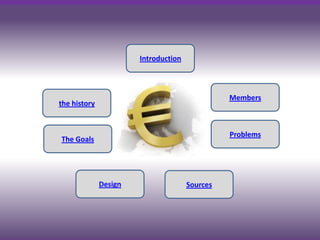
euro currency
- 2. What Is a Euro? The euro is the new currency that many countries that are part of the European Union now use. The symbol for the euro is "€" and its abbreviation is "eur."
- 3. Europe's Move Toward One Currency Starting on January 1, 2002, most Europeans exchanged their change and paper money for a different kind of coins and banknotes. They took their French francs, German marks, Dutch guilders, and other national currencies to the bank and traded them in for euros.
- 4. To help ease exchange rate volatility among different European nations, which hindered investment by companies in various states, the European Union (EU) developed the European Monetary System in 1979. This concept led to the creation of the European Currency Unit.
- 5. Over time, it became clear that closer economic convergence was needed among European nations to build a stronger Europe. In 1991, members of the EU approved the Maastricht Treaty, which called for a single currency throughout Europe for the 21st century. This currency came to be called the euro and was adopted by 12 of the 15 member states of the EU on Jan. 1, 1999. The independent European Central Bank was created to oversee monetary policy.
- 6. The euro began life on January 1, 1999, when exchange rates with "legacy" currencies were irrevocably fixed. For the first two years of its existence, it was only an electronic currency used by banks. The first notes and coins were issued with great fanfare on January 1, 2002, when the euro became legal tender for all transactions in Austria, Belgium, Finland, France, Germany, Greece, Ireland, Italy, L uxembourg, Netherlands, Portuga l and Spain. The old national currencies were phased out over the next few months.
- 8. the euro became legal tender for all transactions in Austria, Belgium, Finland, France, Germany, Greece, Ireland, Italy, Luxembourg, Netherlands, Portugal and Spain. The old national currencies were phased out over the next few months. The only EU states not to adopt the currency were Britain, Denmark and Sweden. The Danes rejected the euro by 53%-47% in a referendum in September 2000, but the Copenhagen government is expected to call a second poll shortly. Sweden is due to hold a referendum on September 14 this year. Many of the EU's 10 new members - Poland, the Czech Republic, Hungary, Slovenia, Slovakia, Estonia, Lithuania, Latvia, Malta and Cyprus - are expected to apply to join the currency when they become part of the Union in 2004.
- 9. • to create a more stable European economy that would invite competition and opportunity for businesses and markets • improve economic growth across Europe. • offer more integration among financial markets. • create a stronger European presence in the global economy and develop a more politically unified Europe.
- 11. • While the euro has brought stability to European economies, the system does have limitations. • All nations that operate under the euro system must, by default, have the same interest rate. • This has created strains on some economies, such as Germany. If its economy slows, the government cannot lower interest rates to stimulate growth. • Despite using a common currency, all European nations have not performed equally economically. • While some nations experienced growth in exports, others were in decline. • While some have gained competitiveness, some have fallen behind. • The hope of some toward political unity is still far from the horizon.
- 13. Euro banknotes in all countries look the same, front and back.
- 14. euro coins have different designs on the backs, depending on which country made each one. the fronts are all the same, but each state uses its own design on the back.
- 15. Notes, which come in denominations of 500, 200, 100, 50, 20, 10 and 5 euros, are identical throughout the EU. Coins carry national symbols on one side and a map of Europe on the other and are available in denominations of 1 and 2 euros and 50, 20, 10, 5, 2 and 1 cents. Notes and coins can be used anywhere within the Eurozone, regardless of country of issue.
- 16. • A recent poll found 45% of Britons want the Queen on euro coins if the UK joins up. • followed by 25% preferring Britannia. • 13% for the Houses of Parliament. • 5% for Shakespeare, • 3% for the Beatles and 1% each for Nelson's Column, Wembley and David Beckham.
- 17. • http://en.wikipedia.org/wiki/Euro • http://www.euintheus.org/ • http://www.investopedia.com/articles/economics/12/behind- the-euro-history-and-future.asp • http://www.cbc.ca/news/background/euro/history.html • http://www.ehow.com/facts_5037633_history-euro- currency.html • http://europa.eu/index_en.htm
